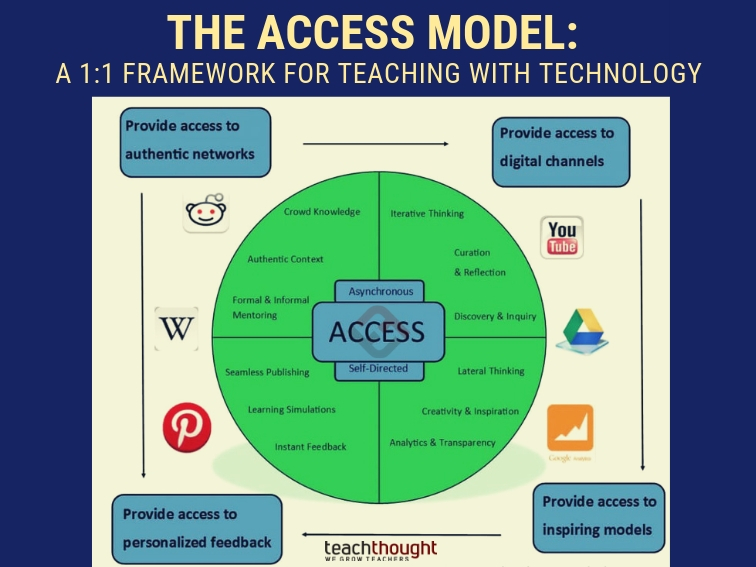
Teaching With Technology Using The Access Model
by Terry Heick
The Access Model is a framework to provide guidance to curriculum designers, policymakers, administrators, committees, and teachers in designing 1:1 teaching and learning resources. It is based on a strength of technology, specifically laptops, iPads and other tablets, BYOD Programs and more.
- In the Access Model, technology provides students with 1:1 access to the people, content channels, models, and instant feedback.
- In most circumstances, this access is ideally asynchronous and self-directed.
- All technology doesn’t need to be the same–one student can use a smartphone while the other uses a Chromebook, for example. What does need to be uniform is the access mentioned above.
- It makes little sense to use technology to provide a learning experience similar to the one provided in its absence. This makes both the technology’s performance and the learning experience clumsy and ineffective.
- A key factor in teaching with technology that–is to rethink the learning process using the potential provided by both 1:1 screen access, and the mobility and personalization they allow.
Piece 1: Students have access to authentic networks
Through apps like reddit, instagram, twitter, 500px, and Quora, students have access to digital communities dedicated to niche topics–e.g., equestrian viral microbiology rather than “science,” or “Use of drones to destroy Constitutional freedom” rather than “Social Studies.”
This provides an organic and affectionate source of content, questions, project ideas, and audiences for publishing thinking, not to mention lifelong membership for always-on learning.
Piece 2: Students have access to filtered and unfiltered digital channels
Through in-the-lap Chromebooks, tablets, smartphones and more, students can access both unfiltered (a YouTube channel on the beauty of mathematics) and filtered (digital textbooks, MOOCs, etc.) content.
Unfiltered doesn’t mean questionable content, but rather ideas and thinking that is packaged by someone other than the teacher–and thus requiring unique skills and understandings to navigate.
Piece 3: Students have access to inspiring models
This is among the most powerful pieces of this framework–access to inspiring models of thought, creativity, design, engineering, performance, etc.
It is through the discovery, curation, and integration of models like these that students can be cognitively and artistically moved to self-direct their own creativity, design, engineering, and performance.
Stumbling on a full-on replica of Manhattan built with Minecraft (see below), the Sistine Chapel built through The Sandbox pixel art, or a YouTube channel dedicated to random acts of kindness can provide students models living and thinking they may not have ever seen before, building background knowledge and possibility.
With their own screens, tools, games, and automated learning software like fluency apps can provide students with instant feedback, visible progress, and guidance to self-direct their own learning in a way that one teacher among 30 students cannot.
This frees the teacher to design the use of these tools, the design of the visible progress, and the ability to self-direct.
The Access Model: A 1:1 Framework For Teaching Technology [Chromebooks, laptops, iPads & Other Tablets, smartphones, and more]
